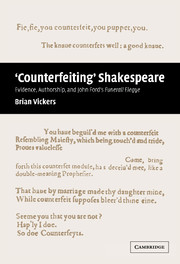Book contents
- Frontmatter
- Contents
- Preface
- List of tables
- List of abbreviations and note on references
- Prologue. Gary Taylor finds a poem
- PART I DONALD FOSTER'S ‘SHAKESPEAREAN’ CONSTRUCT
- 1 ‘W. S.’ and the Elegye for William Peter
- 2 Parallels? Plagiarisms?
- 3 Vocabulary and diction
- 4 Grammar: ‘the Shakespearean “who”’
- 5 Prosody, punctuation, pause patterns
- 6 Rhetoric: ‘the Shakespearean “hendiadys”’
- 7 Statistics and inference
- 8 A poem ‘indistinguishable from Shakespeare’?
- PART II JOHN FORD'S ‘FUNERALL ELEGYE’
- Epilogue. The politics of attribution
- APPENDICES
- Notes
- Bibliography
- Index
5 - Prosody, punctuation, pause patterns
Published online by Cambridge University Press: 10 December 2009
- Frontmatter
- Contents
- Preface
- List of tables
- List of abbreviations and note on references
- Prologue. Gary Taylor finds a poem
- PART I DONALD FOSTER'S ‘SHAKESPEAREAN’ CONSTRUCT
- 1 ‘W. S.’ and the Elegye for William Peter
- 2 Parallels? Plagiarisms?
- 3 Vocabulary and diction
- 4 Grammar: ‘the Shakespearean “who”’
- 5 Prosody, punctuation, pause patterns
- 6 Rhetoric: ‘the Shakespearean “hendiadys”’
- 7 Statistics and inference
- 8 A poem ‘indistinguishable from Shakespeare’?
- PART II JOHN FORD'S ‘FUNERALL ELEGYE’
- Epilogue. The politics of attribution
- APPENDICES
- Notes
- Bibliography
- Index
Summary
In several places Foster claimed to identify distinctly Shakespearian characteristics in the Elegye's verse style. Yet, strangely enough, he made no attempt to use the many studies of Shakespeare's prosody which have appeared over the last two centuries. One might expect a scholar making such a bold attribution to have taken stock of the extant scholarship addressing Shakespeare's metrical practices. Anyone seriously interested in this topic could be expected to know the work of Edward Capell, Charles Bathurst, F. G. Fleay, John Ingram, F. S. Pulling, Goswin König, Hermann Conrad, David L. Chambers, Philip W. Timberlake, Ants Oras, Henri Suhamy, Marina Tarlinskaja, and George T. Wright. Foster briefly referred to Bathurst (1989, p. 86), and cited Chambers and König once each (p. 244), but only to indicate that their statistics differed. Not having taken sufficient account of this scholarly tradition meant that Foster seemingly failed to realize that these studies have established the nature of Shakespeare's prosodic development with remarkable accuracy. Charles Bathurst pointed out that over the course of Shakespeare's career his prosody changed in at least three respects: he varied the position of ‘the caesura … or division of the pauses’; he made fewer pauses at the end of a line, often ‘making the verse end upon a perfectly weak monosyllable’, carrying the movement on to the line following; and he made increasing ‘use of double endings, like the Italian metre’ (Bathurst 1857, pp. 1–3).
- Type
- Chapter
- Information
- 'Counterfeiting' ShakespeareEvidence, Authorship and John Ford's Funerall Elegye, pp. 139 - 162Publisher: Cambridge University PressPrint publication year: 2002



